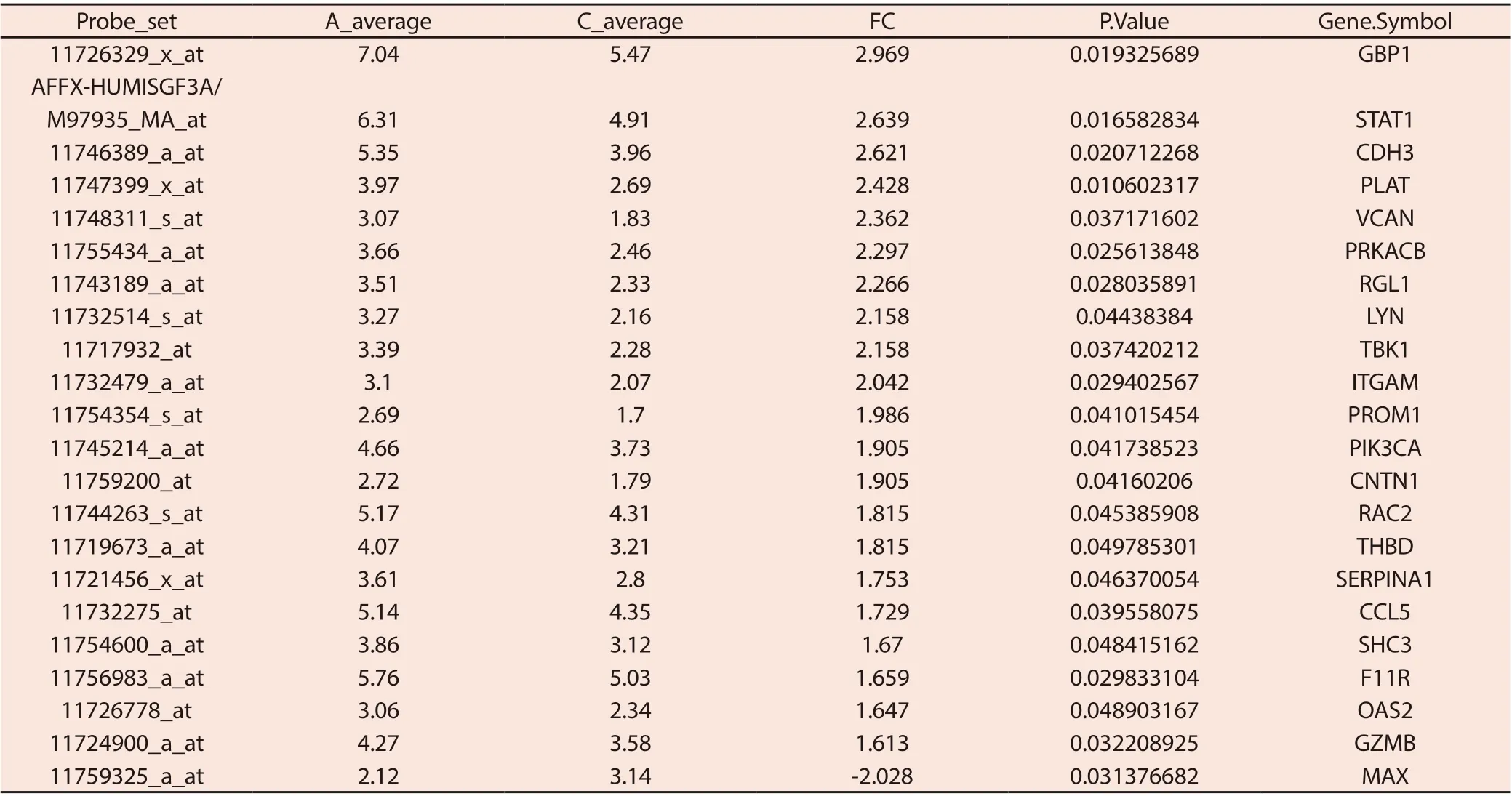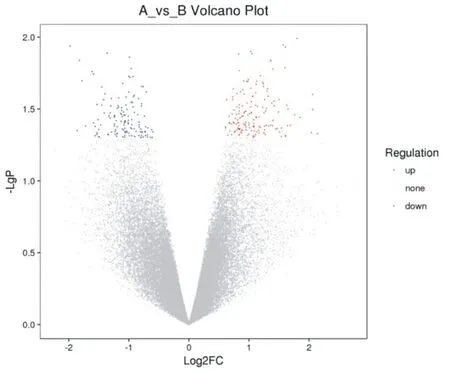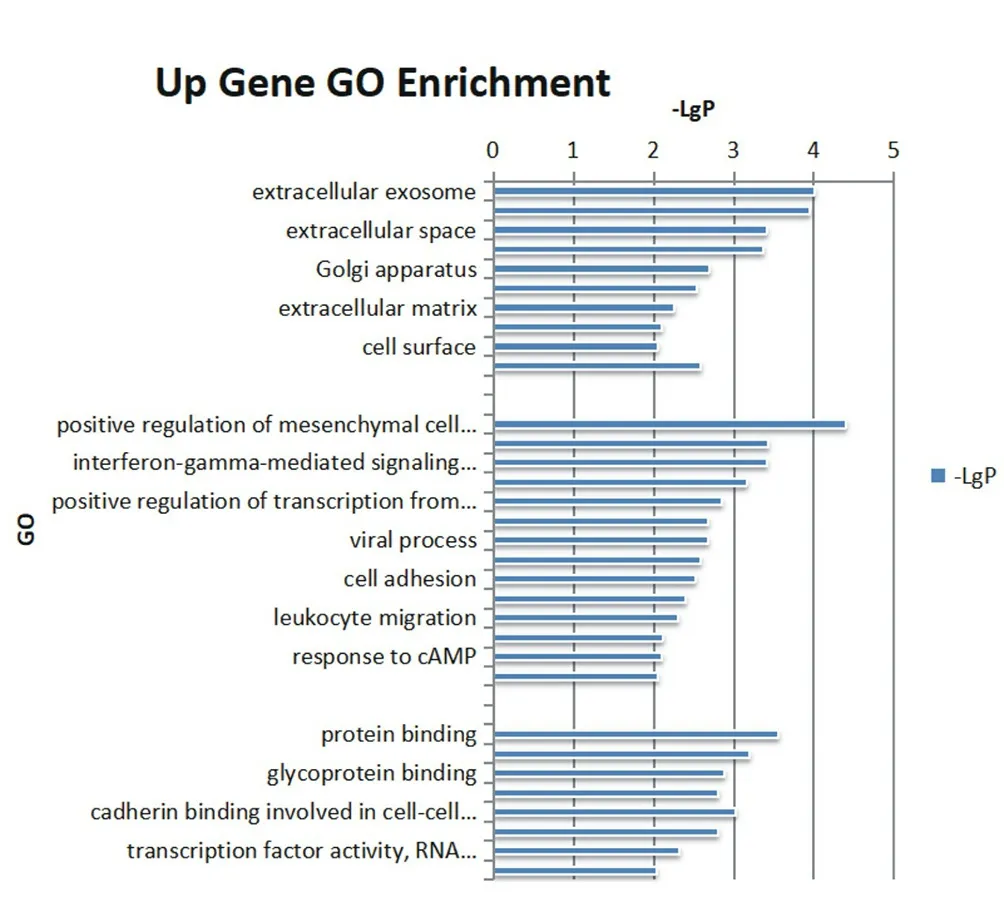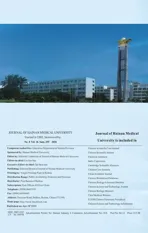Study on the effect of Baiban Ointment on the whole gene expression profile of vulvar sclerosing lichen
2020-07-04MingYuZhaoGuiLanLiuShuHuiLiuJingShiZhuoLi
Ming-Yu Zhao , Gui-Lan Liu, Shu-Hui Liu, Jing Shi, Zhuo Li
Heilongjiang Academy of Chinese medical sciences, Harbin 150036, Heilongjiang
Keywords:Vulvar lichen sclerosus Baiban ointment Whole gene expression profile Signaling pathway
ABSTRACT Objective: To study the effect of Baiban Ointment on gene expression profile of vulvar lichen sclerosus before and after treatment, and to provide theoretical basis for the early diagnosis and clinical treatment of vulvar lichen sclerosus. Methods:Nine patients with vulvar lichen sclerosus diagnosed pathologically were selected as the study object, and the Baiban ointment was applied locally for 3 months. Gene chip technology was used to detect the vulva skin tissue in the same area before and after treatment, and the peripheral normal skin was used as the normal control group to analyze the change of gene expression profile. FC and P values were used as research indicators, and the standard of differential expression was FC value ≥ 1.5, P value < 0.05. The differentially expressed genes were screened, and GO analysis and KEGG database gene pathway analysis were carried out. Results: Compared with the normal control group, there were 22 differentially expressed genes in Group A before treatment, of which 21 were up-regulated and 1 was down regulated; compared with Group B before treatment, there were 23 differentially expressed genes, all of which were up regulated. The differentially expressed genes related to Baiban ointment treatment included TBK1、STAT1、ITGAM、VCAN、PRKACB、PROM1、PLAT、SERPINA1. Go analysis showed that the up-regulated differential genes were mainly concentrated in the extracellular exosome, cytosol, extracellular space, Golgi apparatus and other cellular component, using the biological process such as positive regulation of cell metabolism, signal transduction regulation, cell adhesion, etc., to play a role in protein binding, enzyme activity regulation and other molecular functions. KEGG signaling pathway showed that the differentially expressed genes were significantly enriched in Toll like receptor signaling pathway, Nod like receptor signaling pathway and FcεRI signaling pathway, all of which were up-regulated signaling pathways. Among them, Toll like receptor signaling pathway and Nod like receptor signaling pathway are most closely related to the disease. Conclusion: Baiban ointment may play a role in regulating metabolism, inflammation and immune response by regulating the expression of related genes, affecting the signal transduction such as Toll like receptor signal pathway. The pathway and the genes screened in this study will provide a direction for the future study of this disease.
1. Introduction
Vulva lichen sclerosus (VLS) is a chronic disease characterized by atrophy of vulva and perianal skin, local itching or burning pain [1-2]. The incidence of this disease is high in young women and postmenopausal women, with a malignant change rate of 2% - 4% [3-4]. Baibangao, a traditional Chinese medicine, is widely used in our department. It has a reliable therapeutic effect on VLS and pruritus of vulva. It has a positive therapeutic effect on improving vulva skin atrophy and depigmentation. Based on the results of clinical observation, this study uses gene chip technology to analyze the gene expression profile of baibangao in VLS lesions and vulva normal skin, and to screen the basis of different genes In order to provide scientific basis for the treatment of this disease, the potential mechanism of baibangao on VLS was explored from gene function and signal pathway. The preliminary explanation of its mechanism of action provides a reference for its clinical application.
2. Materials
2.1 General information
From January 2017 to January 2019, 9 VLS patients were selected from the gynecological outpatient department and ward of Heilongjiang traditional Chinese medicine hospital, aged from 18 to 60 years old, who were diagnosed by vulvar pathological biopsy, excluding other autoimmune diseases; those with cancer tendency; those with other serious primary diseases; and those who are allergic to treatment drugs. Those who could not complete the clinical trial were excluded. All the patients signed the informed consent and took the medicine according to the regulations to complete the study. Before and after treatment, the tissues of vulvar lesions and normal skin were collected and included in the gene chip experiment. This experiment was approved by the ethics committee of Heilongjiang traditional Chinese medicine hospital [2016-003-01].
2.2 Method
2.2.1 Gene expression profile detection
In addition to delivering the vulva tissue after the patient's biopsy to the pathology department, another copy of the diseased and normal tissue was taken respectively, which was immediately put into the cryopreservation tube for marking, and then put into the liquid nitrogen bucket to be sent to the ultra-low temperature (- 80 ℃) refrigerator in time for preservation, which was reserved for gene expression profile research. Under the colposcope, the position of the materials should be clearly marked so that the materials can be taken again in the original place. In consideration of the possibility of vulvar cancer in VLS, the scope of biopsy should be paid attention to in the newly diagnosed patients [5]. In the experiment, gene chip preparation, quality control and differential expression gene analysis, Gene Ontology (go) and signal pathway analysis were conducted by Beijing zhongkangbo Biotechnology Co., Ltd.
2.2.2 Treatment
The treatment group was treated with baibangao. The specific methods are as follows: [6]: Rhizoma Rehmanniae 50g, 50g, Astragalus 50g, psoralen 20g, Gentiana grass 20g, Sophora flavescens 40, cicada 20g, 100 part 30g, woodlouse worm 10g, safflower 30g, rhubarb 50g, Angelica dahurica. (the above formula granules of traditional Chinese medicine are provided by the traditional Chinese medicine bureau of our hospital. In the preparation room of our hospital, the formula granules of the corresponding dosage of the above traditional Chinese medicine are hydrolyzed and added with sesame oil and vaseline in proportion after heating. The density of the clear cream is 1.5 times. After the ointment is cooled, it is divided into sealed flasks and stored in a 4 ℃ refrigerator.) Usage: after washing vulva with warm water, apply white spot cream, massage slightly after wiping, once in the morning and once in the evening, 1 month as a course of treatment, 3 courses in total.
3. Results
3.1 Screening and analysis of differentially expressed genes
FC≥1.5 and P < 0.05 were listed as differential expressiongenes. Compared with the normal control group C, there were 22 differential genes in group a before treatment, of which 21 were upregulated and 1 was down regulated, as shown in Table 1. There are 23 differential genes in group a before treatment and group B after treatment, all of which are up-regulated genes, as shown in Table 2. In order to highlight the significance of gene differential expression, before treatment group A and normal control group C, before treatment group A and after treatment group B, according to p value and FC value, jointly draw a volcano plot, the horizontal axis represents the probe or gene multiple of difference (fold change), the vertical axis represents the probe or gene difference significance (- log10 p-value) see Figure 1, figure 2.

Table 1 Differentially expressed genes between group A and group C

Table 2 differentially expressed genes between group A and group B

Figure 1. Volcano map of differentially expressed genes in group A and group C

Figure 2. Volcano map of differentially expressed genes between group A and group B
3.2 Differential gene analysis based on go database
The difference genes were annotated by go database, and then the significance level P value and misjudgment rate (FDR) of each function were calculated by Fisher exact test and multiple comparison test. So the significant function of the gene was screened, the standard was p < 0.01. See Figure 3.
The differentially expressed genes are mainly concentrated in the extracellular body, cytoplasm, extracellular space, Golgi body and other cell components. They play the molecular functions of protein binding and enzyme activity regulation by using the biological processes of positive cell metabolism regulation, signal transduction regulation, cell adhesion and so on.

Fig. 3 Histogram of go enrichment
Horizontal axis - log10 (p_value): take the logarithm of P value and then take the negative value. The larger the value of - LGP is, the smaller the value of P is, the higher the significance level of go is; vertical axis go_name: the name of gene function (go), which is consistent with the naming method in the gene ontology database.
3.3 KEGG pathway analysis of differentially expressed genes

Fig. 4 Histogram of pathway enrichment
The results showed that the signal pathways of different expression genes were toll like receptor, nod like receptor, FC ε RI, NF - κ B pathway and so on. See Figure 4.Horizontal axis - log10 (p_value): take the logarithm of P value and then take the negative value. The larger the value of - LGP is, the smaller the value of P is, the higher the significance level of pathway is; vertical axis pathway_name: the name of pathway in KEGG database.
4. Discussion
Gene chip technology is a kind of biochip technology which uses micro technology to detect nucleic acid. It can detect thousands of gene information at the same time [7]. This technology can be used in medicine to find disease susceptible genes, carry out disease diagnosis, gene function confirmation and drug screening.
Lichen sclerosus of vulva is a disease characterized by atrophy and thinning of vulva skin and white color of local area. It is called vulvar white disease together with squamous cell hyperplasia of vulva. In the past, it was also called vulvar leukoplakia and atrophic malnutrition [8]. The disease has a long course and is easy to be repeated. In the later stage, it can cause abnormal anatomical structure and seriously affect the physical and mental health of women patients. Western medicine treatment is mainly local application of steroids, and can be combined with physical therapy
[9]. At present, there are many problems in western medicine, such as large side effects, repeated drug withdrawal and so on. Traditional Chinese medicine ascribes this disease to anterior yin disease, and it has unique advantages in treating this disease. Baiban cream has been used for many years by the research group. The formula is excellent and the drug resistance is moderate. It can obviously reduce the patients' self-conscious symptoms, correct the signs of atrophy and whiteness, and improve the patients' quality of life. It is popular with clinical patients. At present, sclerosing lichen vulvae has many pathogenic factors, which is related to immune genetic factors. With the continuous progress of molecular biology, the correlation between various genes and the disease has been continuously confirmed [10-11]. In order to screen out the core genes and signal pathways of the disease, further explain the mechanism of Baiban cream on the disease, and verify the molecular mechanism of the change of the causes of the disease before and after medication, we used gene chip technology to study the same skin before and after medication The changes of skin gene expression profile were compared.
The results of gene expression profile analysis showed that there were 22 differentially expressed genes in group a before treatment, including 21 up-regulated genes and 1 down regulated genes, compared with group C after treatment, and 23 up regulated genes in group a before treatment and group B after treatment. The differentially expressed genes related to baibangao treatment included tbk1, STAT1, itgam, Vcan, prkacb, prom1, plat and serpina1. It is suggested that these genes may be the target of baibangao in the treatment of VLS.
Gene Ontology (go) database can make the functional descriptions of genes or gene products in various databases consistent, covering three aspects of gene function: cell component, molecular function and biological process. Based on the go database, significant, accurate and targeted gene functions representing the target gene group were selected, and gene function annotation was carried out to compare the significant functions of genes. In this study, go analysis showed that the up-regulated differential genes were mainly concentrated in extracellular body, cytoplasmic, extracellular space, Golgi body and other cell components, which played a role in protein binding, enzyme activity regulation and other molecular functions by using biological processes such as positive regulation of cell metabolism, signal transduction regulation, cell adhesion and so on.
KEGG is a database for systematic analysis of gene (and its encoded products) relationships, gene functions, and genomic information. It is a powerful tool for the study of metabolism in vivo. The selected differential genes were annotated based on KEGG database to get all the pathways involved. Then, Fisher's exact test and multiple comparison test were used to calculate the significance level P value and error rate FDR of each signal pathway. So we can screen out the pathway of gene. The pathway results showed that the differentially expressed genes were significantly enriched in Toll like receptor signaling pathway, nod like receptor signaling pathway, FC ε RI, NF - κ B signaling pathway, among which toll like receptor signaling pathway, nod like receptor signaling pathway were most closely related to the disease. These pathways are mainly related to immune system and signal transduction in KEGG database.
In recent years, the role of Toll like receptors has been studied extensively. Toll like receptor family is huge, and each member receptor plays an important role in inflammatory response, tumor, immunity and various gynecological diseases [12-14]. When toll like receptors are stimulated, they release inflammatory factors, which activate the effective immune response of the body. Nod like receptor and toll like receptor are both immune receptors. When pathogens invade or tissue damage, macrophages, neutrophils, etc. can be collected through immune response, thus starting the process of tissue repair [15-17]. NF - κ B is the main transcription factor regulating immune response. NF - κ B signaling pathway is regulated by a variety of signaling molecules and cytokines, so as to induce inflammation in the body [18-19]. FCεRI plays an important role in allergic reactions [20], and the signal transduction pathway mediated by FC ε RI is a major pathway leading to allergic symptoms [21].
It can be seen that the above pathways are closely related to immune response, inflammation inhibition, allergic changes and so on. VLS has been considered as an immune genetic disease related to infection, trauma and other factors. It can be seen that the above pathway is likely to be the target of baibangao in improving and treating VLS. In fact, many pathways have similarities in the regulation of different diseases, and the effect of drugs on diseases is precisely produced by regulating the pathway or the factors acting on the pathway. Each disease is not only regulated by a single signal pathway, but also plays a leading role in different stages of the disease. Baibangao may act on some factors in the above pathway and cause signal transduction in the pathway, so as to play the role of drugs. However, this conclusion needs to be further verified. The follow-up research group will carry out quantitative detection such as PCR to further verify.
杂志排行
Journal of Hainan Medical College的其它文章
- Clinical effect of preventive nursing on the rate of deep vein thrombosis in patients with lung cancer: A meta-analysis
- A network pharmacology approach to explore action mechanisms of Bi xie and Tu fuling for treating gouty arthritis
- Study on the value of parecoxib sodium preemptive analgesia for laparoscopic surgery based on postoperative pain and stress mediator secretion
- Changes of serum β2-MG, Cys C and urine mAlb levels in patients with ureteral calculi before and after extracorporeal shock wave lithotripsy and their clinical significance
- To investigate the effects of butylphthalide on reducing neuronal apoptosis in rats with cerebral infarction by inhibiting the JNK / P38 MAPK signaling pathway
- Study of KAP status and influencing factors of Protective Behaviour on COVID-19 among Hainan Mobile Phone Users
